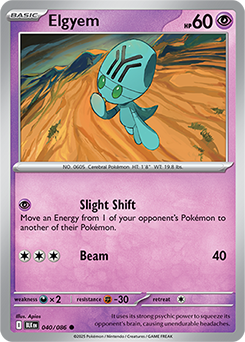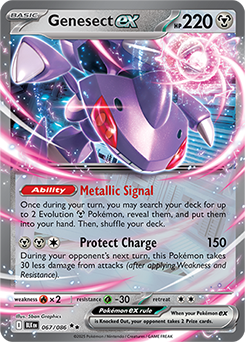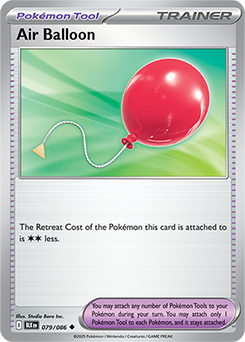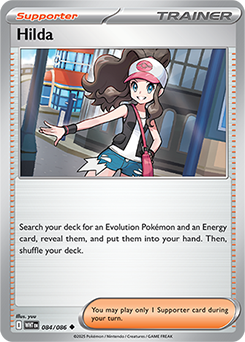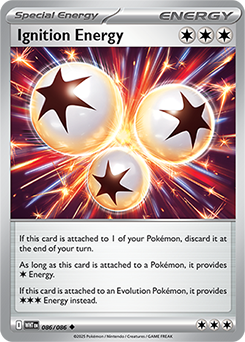By Xander Pero, Contributing Writer
Unova region lovers unite! The newest pair of expansions, Scarlet & Violet—Black Bolt and Scarlet & Violet—White Flare, reintroduce and revitalize nostalgic favorites from the original Black & White expansions, which debuted in 2011. Since then, the game evolved and new behemoths reign in the 2025 Standard format. Will these Unova legends thrive within the new realm of play? Read on to find out which cards may take the crown at the 2025 World Championships and beyond.
In my opinion, Jellicent ex is the strongest card emerging from the pair of expansions. Budew’s success has shown us that Item lock is a strong form of disruption. Jellicent ex takes this disruption one step further: it also blocks the opponent from playing Pokémon Tool cards. Most importantly, this stops Technical Machine: Evolution, which has been the top way to counter Item lock while trying to evolve Pokémon. Moreover, Jellicent ex has a respectably powerful attack, swinging for either 80 or 160 damage depending on the number of Energy attached to it. This means that you can now apply significant pressure while maintaining the Item and Tool lock, which was not possible before with Budew. All in all, I think Jellicent ex will make waves in Standard.
The first and most obvious way to play Jellicent ex is alongside Gardevoir ex. They’re both Psychic-type Pokémon, and Gardevoir ex can fulfill the Floating Pokémon’s attack cost easily. I’ve seen some deck lists play a two–two copy of Jellicent ex, choosing instead to remove some of the auxiliary cards like Drifloon, Bravery Charm, and Cleffa, or Budew. The new strategy is to use Jellicent ex, Scream Tail, and Munkidori to whittle down an opponent’s board with damage counters over time.
Although Jellicent ex isn’t necessary for Gardevoir ex to be successful, I imagine most players will include Jellicent ex due to its strength in the mirror match. This works because Gardevoir ex decks typically play only a single copy of Boss’s Orders, which is the main way to remove a pesky Defending Pokémon. Therefore, the opponent must try to go through the Jellicent ex, but that can prove difficult without a Jellicent ex of their own. Using Gardevoir ex leaves it vulnerable to a Technical Machine: Devolution, whereas using Scream Tail or Drifloon leaves you vulnerable to Munkidori or a return KO with a normal attack. Then, the opponent cannot use Night Stretcher to recover their attacker immediately because of Item lock.
The second approach to playing Jellicent ex is to forget about Gardevoir ex entirely. Instead, you attack with Jellicent ex most of the time and then use the extra deck space to play additional consistency cards, disruption cards, or cards that are especially versatile overall. The upside to this approach is that you end up with additional space to work with and can execute your Jelli-centric strategy more frequently. The downside is that you lose access to Gardevoir ex and the benefits that come with it, such as damage from Scream Tail and Munkidori on demand. I’m not sure how popular this deck variant will be, but it’s worth thinking about as you prepare for upcoming tournaments. We’ve seen in the past that pure Item lock decks can succeed in the right conditions, so I wouldn’t be surprised if that were the case here.
The main downside of Jellicent ex decks is that Item-based decks are less likely to succeed without adapting to rival archetypes. Iron Bundle and Flutter Mane are great additions if you have a good way to locate them in your deck during play. However, both cards have their drawbacks. If the opponent has two Jellicent ex, for example, the opponent can promote their second Jellicent ex after announcing Iron Bundle’s Hyper Blower, maintaining the Item lock. Flutter Mane is a foolproof counter, but only when it is your Active Pokémon, which would require an additional step to function. I bet decks like Gholdengo ex will add a copy of Iron Bundle to get around Jellicent ex, but I also expect these decks to decline in popularity rather than accept the uphill battle against the best deck in the format.
Elgyem may not look like much at first glance. However, its first attack, Slight Shift, is capable of dismantling opposing decks that are reliant upon their single Energy attachment per turn. One such deck, Dragapult ex, plays the first few turns of the game patiently. With Elgyem, you can move Energy from your opponent’s Drakloak to another Pokémon like Duskull, Budew, or Munkidori, which could prevent them from attacking with Phantom Dive. This is a much easier way to buy time against Dragapult ex opponents than the old method, which would be to find Boss’s Orders each turn to target Drakloak. However, doing so can be difficult to do under Item lock, especially for other slow decks.
Another use for Elgyem is to slow down Munkidori-based decks. Marnie’s Grimmsnarl ex and Gardevoir ex dedicate their single attachment per turn to Munkidori, making use of their powerful Energy acceleration Abilities to empower their main attackers. With Elgyem, you could move one or two Energy before the opponent has the chance to retaliate, allowing you to get ahead of its Adrena-Brain Ability.
Though it’s a niche idea, I expect Elgyem to improve the viability of control decks, particularly Pidgeot ex variants. Older versions of the deck used Turtonator or Paldean Tauros to slow down opposing attackers. However, those only targeted the Defending Pokémon, making counters reactive rather than proactive. Time will tell if someone can find a way to crack the code on Pidgeot ex control decks. They may have declined in competitive representation since the rotation, but Elgyem could be the factor that pushes this deck back into the spotlight.
Today’s Standard format is defined by strong consistency engines thanks to the threat of Budew. Although playing a high Supporter count is a way to improve consistency, you’re limited by deck space. Another underrated aspect is variance—without any Pokémon-based draw, a single hand that’s without a Supporter could spell disaster. Moreover, it can be difficult to find time to play Boss’s Orders or non-draw Supporter cards when you’re fully reliant on Professor’s Research, Arven, or Iono.
Genesect ex provides an easy means for finding Metal-type Evolution Pokémon with its Metallic Signal Ability. Gholdengo ex decks typically rely on Technical Machine: Evolution, which can be found with Arven. Adding Genesect ex into the equation means that a single Nest Ball can find as many Gholdengo ex as needed, increasing the odds of attacking on the second turn of the game and bolstering consistency. While I still expect these decks to play four Arven and a copy of Technical Machine: Evolution, Genesect ex provides a solid backup option.
Unfortunately, there aren’t many other Metal-type Pokémon that can stand up to the powerhouses of the Standard format. I’ve personally toyed with Steven’s Metagross ex and Archaludon ex, but I haven’t been able to find a winning strategy with them yet. Steven’s Metagross ex is eclipsed by Gardevoir ex—there aren’t enough other Metal-type Pokémon to justify the need for the dual typing. Archaludon ex decks typically play a high count of Ultra Ball anyway to rapidly discard Metal Energy, fueling Assemble Alloy.
I’m looking forward to seeing the Metal-type Pokémon that debut in the next two years!
Tools and effects that reduce Retreat Cost have always been popular, and Air Balloon will be no exception. Rescue Board already sees play in a few niche decks despite only reducing a Pokémon’s Retreat Cost by 1 in most cases. Air Balloon, however, can lift liabilities into nimble athletes.
N’s Zoroark ex is one such example. Its Trade Ability provides decks a surefire way to draw cards without systemic use of Supporter cards. While it could be played as its own archetype outright, pairing with other N’s Pokémon for Night Joker, other decks employ one or two copies purely for its Ability. In these cases, its biggest liability is its Retreat Cost of 2. An opponent could also use a card like Counter Catcher or Boss’s Orders to whisk N’s Zoroark ex to the Active Spot, then target Benched Pokémon. With Air Balloon, you can retreat N’s Zoroark ex without any additional Energy.
Marnie’s Grimmsnarl ex and Gholdengo ex are two additional examples of Pokémon that can greatly benefit from Air Balloon. One common strategy in the Marnie’s Grimmsnarl ex versus Gardevoir ex matchup is to use Munkidori’s Mind Bend attack to make the attacking Marnie’s Grimmsnarl ex Confused, either forcing the opponent to discard Energy or leave an attack up to chance. Air Balloon allows you to retreat Marnie’s Grimmsnarl ex for no cost and maintain your offensive.
The argument for Gholdengo ex is similar. Dragapult ex opponents may use Counter Catcher and Itchy Pollen on a zero-Energy Gholdengo ex, forcing you to locate another Metal Energy without Items. With Air Balloon, you can easily retreat into your original Gholdengo ex with an attached Metal Energy—you may even snag an additional card with Coin Bonus!
Hilda is an enigmatic Supporter because its effects fall somewhere between Arven and Colress’s Tenacity. Let’s start with Arven. It’s incredibly strong due to Technical Machine: Evolution, which can accelerate an Evolution deck’s capabilities to that of an aggressive one. Outside of that, though, it’s flexible in finding the right Item at any time. If you’re missing Rare Candy, you can get it immediately! If you need more than just that, Secret Box will do the trick. The one downside is a susceptibility to Item lock, which can turn Arven into dead weight without a useful Tool.
On the other hand, Colress’s Tenacity hasn’t seen much play since its release. It’s hard to justify playing a Supporter to find a Basic Energy when Earthen Vessel and Crispin exist. Moreover, the most popular Stadium card is Artazon, which, while useful, is usable by each and every deck in format, which means that you’re ultimately providing the same benefit to every opponent. Certain niche Stadiums like Jamming Tower or Team Rocket’s Watchtower exist too, but those are typically paired with Iono, so using Colress’s Tenacity is typically ineffective. This only leaves Special Energy as the main upside, which has been rather weak since the rotation of F-block cards.
There are two reasons why I believe Hilda could succeed. First, the hypothetical increase of Item and Tool lock in the form of Jellicent ex could dampen Arven’s viability as a mid-game Supporter. Second, for the right kind of deck, it fulfills a niche similar to that of Ciphermaniac’s Codebreaking. Its closest comparison would be Jacq or Brock’s Scouting, which are great for decks like Dragapult ex where having more Pokémon is better. Hilda could also find timely Special Energy like Neo Upper Energy, Reversal Energy, or the newly released Ignition Energy. We may need to wait until Arven and Technical Machine: Evolution depart from the Standard format before this Unova Trainer is fully accepted, but Hilda’s time to shine may come sooner rather than later.
I’ll close with my favorite dark horse from the new set: Ignition Energy. Its effect resembles Triple Acceleration Energy, which was a cornerstone for certain Evolution Pokémon during the 2019 circuit: Dewgong, Persian-GX, and Naganadel-GX. Although you must discard Ignition Energy at the end of your turn, the benefit of fulfilling 3 Energy with one attachment should be recognized. Unlike Reversal Energy, Ignition Energy can only fulfill Colorless Energy, but it has the added benefit of being able to be attached to Rule Box Pokémon, and it functions while even or ahead on Prize cards. The cards simply fulfill different purposes.
I haven’t yet found the perfect way to jumpstart Ignition Energy’s success in the Standard format, but I have some immediate ideas I’d like to try out: Jellicent ex, Team Rocket’s Porygon-Z, and Slaking ex.
I hope you enjoyed learning about a few of the must-watch cards from the new pair of expansions, Scarlet & Violet—Black Bolt and Scarlet & Violet—White Flare. I’m excited to see how things shape up, both at the 2025 World Championships and in the upcoming competitive season. What new strategies will you uncover?

Xander Pero is a contributing writer for Pokemon.com. He was an avid Pokémon fan even before discovering sanctioned tournaments in 2009. He has since won three Regional Championships and finished third at the 2017 World Championships and third at the 2025 Europe International Championships, all in the Masters Division. He continues to compete in tournaments often, but he now focuses on working as a data analyst in New York City. You can find him at various tournaments, as well as on X at @xanderpero.
Source link

